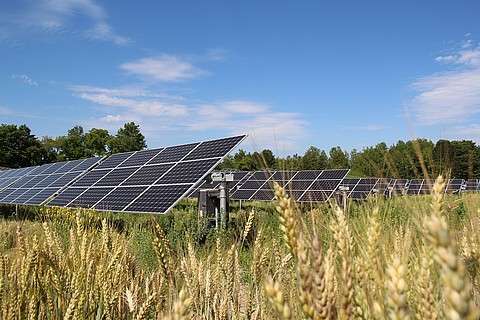Even the most traditional energy economies can make the transition to renewables -- and community solar can lead the way.
Posted to D. Pichard’s LinkedIn profile, Nov. 20, 2020
Posted to D. Pichard’s LinkedIn profile, Nov. 20, 2020

Amid political hyperbole and economic downturn, it is encouraging to see traditional energy economies reinventing themselves across North America. In recent surveys in Pennsylvania, for example, consumers overwhelmingly viewed community solar as a way to stimulate significant economic opportunity in the Keystone State.
Community solar, also known as “shared solar,” makes photovoltaic (PV) energy available to people who can’t install a system on their own home or business. Renters and homeowners with shaded roofs can now reap the economic and environmental benefits of solar energy by purchasing electricity from the new community farm. Across the U.S., sensible policies have resulted in at least one community solar project being online in more than 40 states.
Letting the Sun Shine in the Keystone State
Existing Pennsylvania law blocks community solar projects, despite “nearly 80% of Pennsylvania voters” believing their legislature should pass a bill allowing consumers to enroll, according to Susquehanna Polling and Research. Pennsylvanians --both Republicans (65% of survey respondents) and Democrats (85%) --overwhelmingly support the economic and sustainability benefits of community solar, should solar PV projects in the queue get the green light.
Meanwhile, a recent Penn State study of 235 planned community solar projects shows that building these installations would:
● Generate an estimated $1.8 billion in economic impact
● Create over $793 million in labor income
● Spur over 11,000 jobs in various sectors across the state
Farming, along with construction, hospitality, tourism, and other major sectors, has suffered due to the COVID-19 pandemic. During a time when Pennsylvania farmers are grappling with a depressed economy, community solar could enable them to reap the same energy harvests as their counterparts in more solar-savvy states.
New Leadership Aims to Shift State’s Energy Economy
Pennsylvania’s energy laws reflect the clout of its entrenched oil and gas sector. As the third-largest net supplier of energy to other states, Pennsylvania's natural gas production reached almost 7 trillion cubic feet in 2019, ranking second after Texas. As the third-largest coal-producing state in the nation in 2018, Pennsylvania was the second-largest coal exporter to foreign markets that year.
But Pennsylvania Governor Tom Wolf has set a goal to “protect clean air, clean water and public health and conserve working farms, forests and natural lands”. In 2019, Wolf signed executive orders establishing the first statewide goal to reduce greenhouse gas emissions, mandating a 26% reduction of net greenhouse gas emissions by 2025 from 2005 levels and an 80% reduction by 2050.
After the 2020 presidential election, Wolf may be set to receive help instead of hindrance from the federal government. The election of an environmentally engaged administration is expected to reset U.S. energy policy and add momentum to ambitious agendas like the governor’s.
Alberta Renewable Energy Rush Challenges Dominance of Oil and Gas
Pennsylvania PV could heed lessons from a trailblazing region to the north. Like other traditional markets that have made the shift to clean energy, Canada’s Alberta Province is charting a path forward for renewables--including community solar. Alberta’s oil-sands production has made oil and gas its top export category for years. But the province’s commitment to phasing out coal by 2030 opens the door for wind and solar to play a larger role. Analysts predict that 83% of the combined utility-scale wind and solar capacity built in Canada over the next five years will be in Alberta, with solar representing 1.8 GW by 2025.
Workforce Transitioning -- Lessons From Alberta’s Clean Energy Revolution
Advantages being played out in communities across Alberta are also believed possible in the Keystone State. The Coalition for Community Solar Access recently reported there is a “tremendous economic boost community solar projects can provide to communities…including rural, urban and suburban regions” of Pennsylvania.
Alberta’s oil and gas tradespeople hold high onsite standards, thrive on hard work and are committed to creating a new energy future. Harnessing their experience and skill is helping Alberta’s solar PV sites reach greater levels of operational excellence.
Pennsylvanians with oil and gas experience can make the switch to solar just as effectively and bring valuable skills to the transition. And much like communities in rural Alberta, Pennsylvania towns will appreciate the economic uptick that comes with more people moving through the area and heightened business for the service industries.
GP JOULE Brings Canadian EPC Expertise to Pennsylvania Community Solar Market
GP JOULE North America is engaged in markets very similar to Pennsylvania and has experience across the U.S. and Canada building community solar and utility-scale size projects. Bringing turnkey engineering, procurement and construction experience to energy-rich regions like Pennsylvania is our sweet spot. As Alberta has shown, moving away from oil and gas opens the door to clean-energy jobs and a more diverse energy infrastructure for future generations. When state legislators honor the preferences of so many Pennsylvanians and fully support community solar, GP JOULE will be ready to aid the transition to a brighter future.